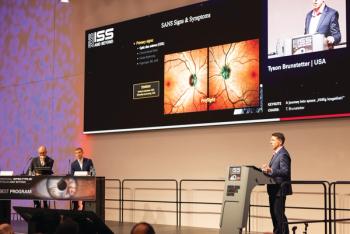
Plastic fantastic
As always, there is a steep learning curve when dealing with new technologies but it is clear that outcomes with AlphaCor are continuing to improve
How is it implanted?
The 'standard' procedure, developed during clinical trials, involves an extensive half-thickness incision 1.5 mm posterior to the limbus, through 180°, extended to create a central lamellar corneal pocket of 7.5 mm diameter open to the superior limbus. This allows access for a sharp skin biopsy punch, initially 3.0 mm, now generally 3.5 mm in diameter, used to enter the anterior chamber. The large incision is required to allow access for the trephine, but has disadvantages including significant peri-limbal disturbance, dissection over the old PK wound and a need to place a mattress suture to appose the lamellae adjacent to the device's upper edge, to prevent migration, prior to closing the scleral wound.
Trial & error
About two years ago there was a trend towards trying to reduce the incision length by using a 'low profile trephine' that obviated the need for a wide exposure to allow posterior stromal trephination. After extensive evaluation, it was found that the technique was often technically difficult, with the prototype trephines insufficiently sharp and scissors required to complete the posterior opening. This method is not currently used.
Lessons learned
There has been some interest in using femtosecond lasers to create the lamellar pocket dissection and entry wound. Evidence is currently limited but there are further studies planned which hope to clarify the benefits of its use.
Newsletter
Get the essential updates shaping the future of pharma manufacturing and compliance—subscribe today to Pharmaceutical Technology and never miss a breakthrough.












































